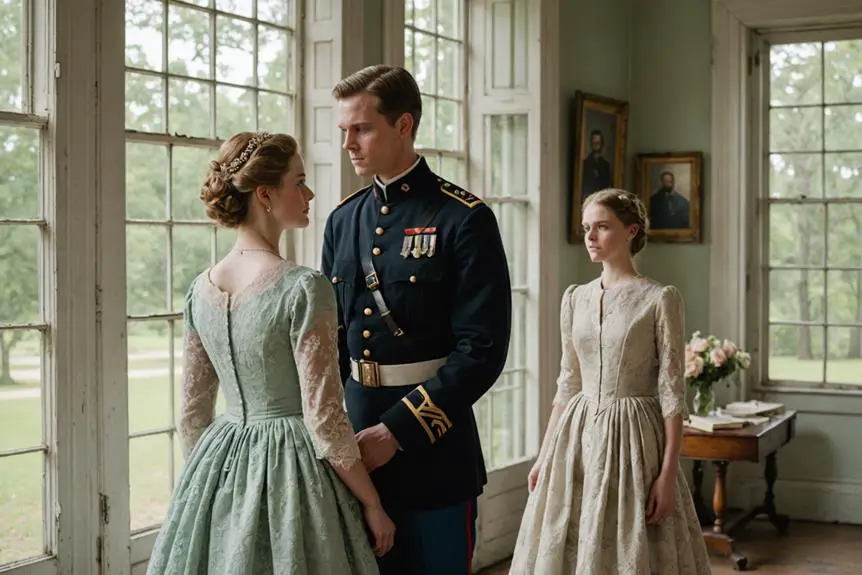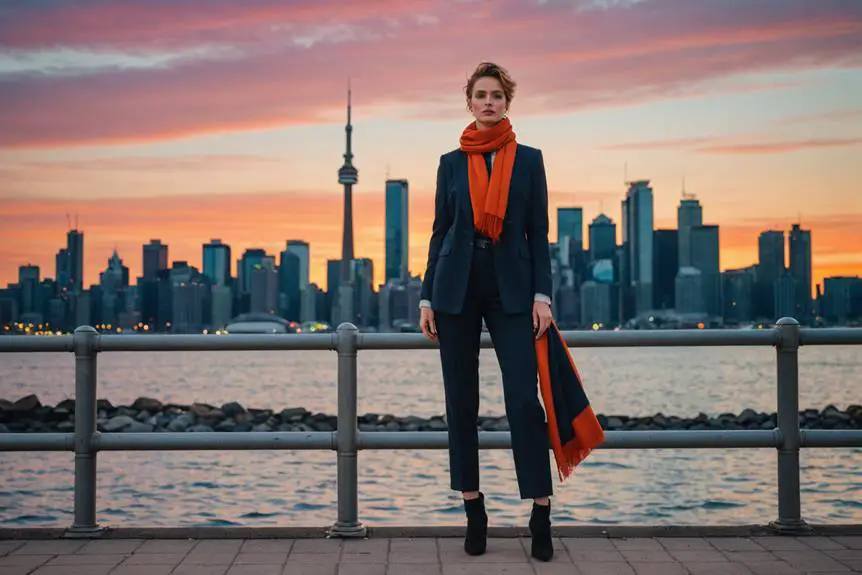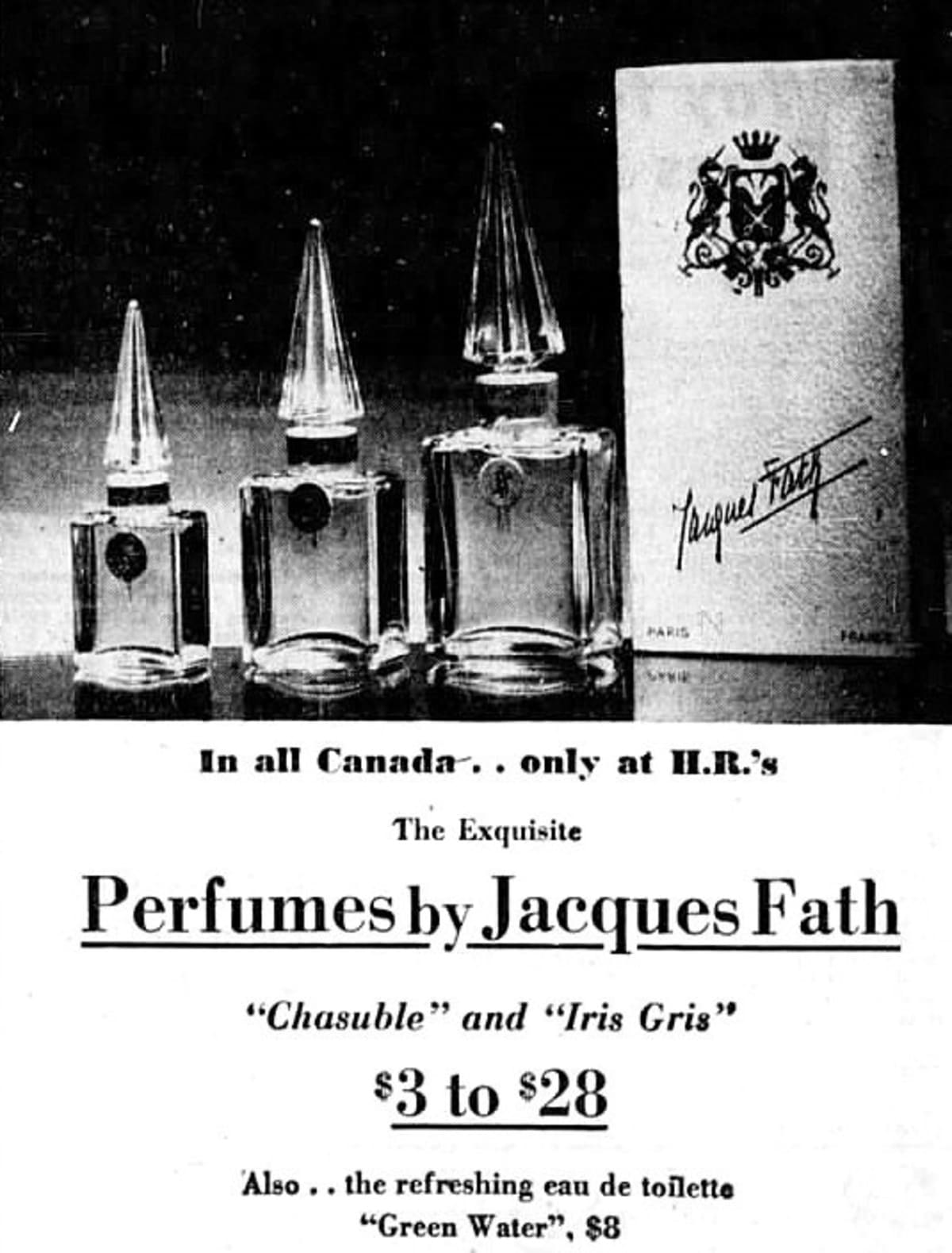In "The Beguiled," delicate vintage dresses contrast sharply with the tension of a war-torn backdrop. You might find it intriguing how each character's outfit not only reflects their personality but also subtly conveys underlying themes of desire and control. Consider Miss Martha's structured ivory attire against Edwina's softer pastels; their choices speak volumes about their emotional states. As you think about these visual narratives, it raises questions about how costume design influences both character development and the overall atmosphere of the film. What role do you believe these outfits play in shaping the story?
Overview of The Beguiled
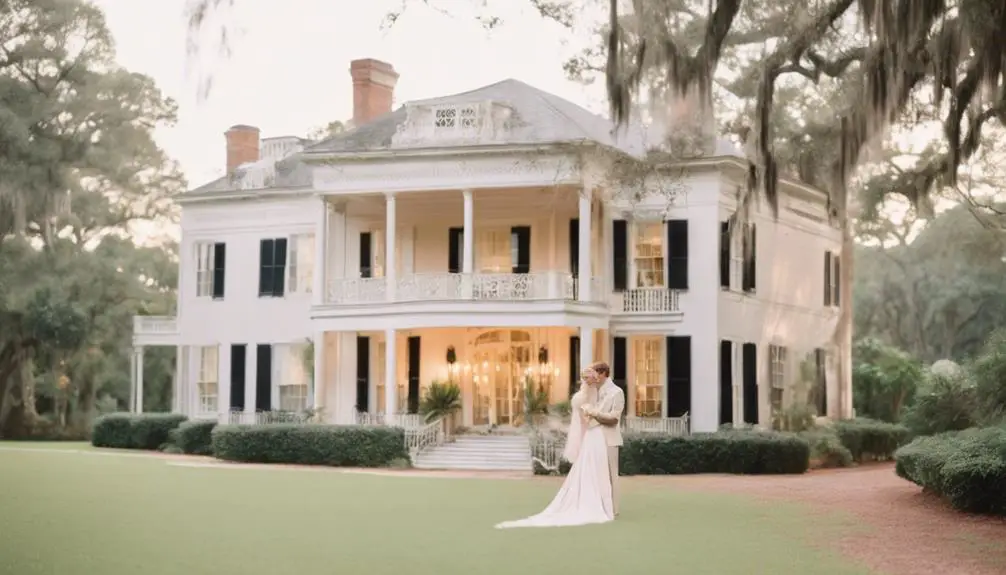
Set against the backdrop of the American Civil War, "The Beguiled" immerses you in the tense world of a Southern girls' boarding school in 1864. Directed by Sofia Coppola, this gripping tale unfolds as a wounded Union soldier seeks refuge at the seminary, igniting a whirlwind of emotions among the women. The film showcases an impressive cast, including Nicole Kidman, who plays the character Martha, alongside Kirsten Dunst and Elle Fanning, each delivering enthralling performances that bring their roles to life.
Costume designer Stacey Battat plays a significant role in establishing the film's aesthetic. Through her use of light fabrics that appear ethereal and diaphanous, she transports you to a time when elegance met the harsh realities of war. The costumes reflect the delicate balance of femininity and underlying tension present in the story. With the film premiering at the Cannes Film Festival and receiving acclaim, including Coppola's Best Director award, "The Beguiled" stands as a striking portrayal of desire, conflict, and the complexities of human interaction in a world fraught with danger.
Costume Design Process
In the costume design process for "The Beguiled," you'll see a remarkable collaborative effort that brings together Stacey Battat, director Sofia Coppola, and production designer Anne Ross, all working in harmony to create a visually stunning film. This collaboration mirrors the intricate designs seen in 1970s coat trends, where diverse styles and bold aesthetics played a significant role in defining the fashion of the era. They conducted thorough historical research, particularly at the Metropolitan Museum of Art, where insights into Civil War-era women's fashion guided their design choices. By blending meticulous attention to detail with a modern twist, they crafted custom-made outfits that not only reflect individual character styles but also evoke a dreamy, ethereal quality that enhances the film's atmosphere.
Collaborative Design Approach
A collaborative design approach was vital in bringing the costumes of 'The Beguiled' to life. Led by Stacey Battat, the costume design process thrived on close teamwork with director Sofia Coppola and production designer Anne Ross. This collaboration guaranteed a unified artistic vision that captivated audiences. The team conducted extensive research at the Metropolitan Museum of Art, diving deep into period fabrics and swatch books to inform their designs, which prioritized historical accuracy while embracing a contemporary twist.
Approximately 90% of the costumes were custom-made, reflecting a commitment to tailoring that accommodated individual body types and enhanced performers' comfort. Battat and her team utilized soft pastel colors, historically available yet rarely worn during the Civil War era, adding a unique touch to the film's visual narrative. Their goal was to achieve an ethereal aesthetic, which they accomplished through trial-and-error techniques for fabric fading, creating stunning visual effects that resonated with the story's mood. This collaborative approach not only enriched the overall design but also allowed each member's strengths to shine, culminating in a harmonious blend of artistry that brought the world of 'The Beguiled' to life.
Historical Research Insights
Building on the collaborative design approach, the historical research insights played a pivotal role in shaping the costumes for "The Beguiled." Costume designer Stacey Battat and her team immersed themselves in the textiles and clothing styles from the 1850-1863 period at the Metropolitan Museum of Art. Their commitment to historical accuracy guaranteed that every piece reflected the Civil War era's complexities.
Through extensive research, Battat explored various dyeing techniques and the availability of fabrics during that time, which led to the ethereal, pastel aesthetic chosen for the film. While pastel colors were historically available, they were seldom worn, sparking intriguing discussions about their appropriateness in conveying the characters' identities. This attention to detail didn't stop there; Battat meticulously examined period silhouettes to create costumes that not only adhered to historical standards but also highlighted the distinct narratives of each character.
Character Wardrobe Highlights
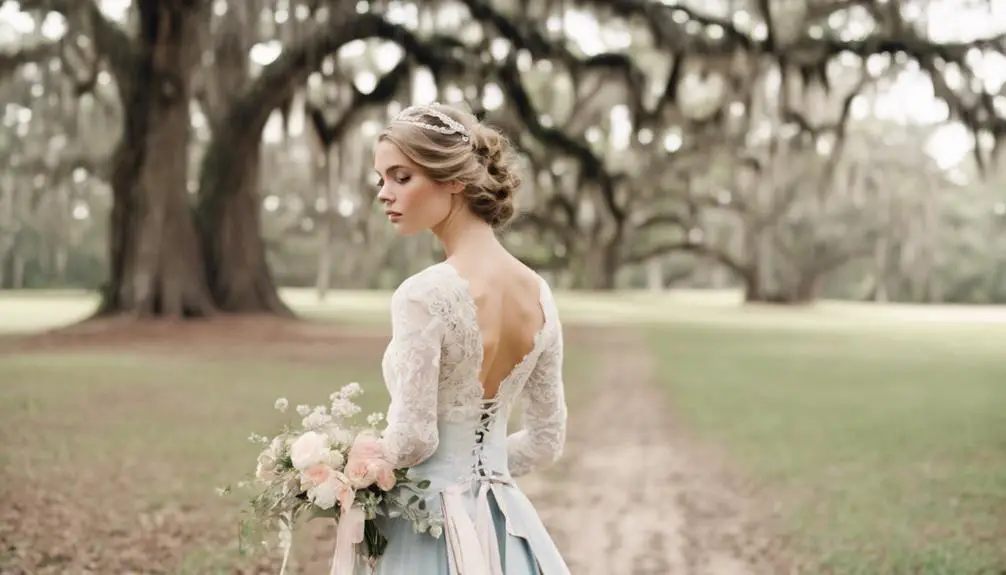
Character wardrobes in "The Beguiled" vividly reflect their personalities and struggles against the backdrop of the Civil War. Miss Martha, portrayed by Nicole Kidman, embodies authority with her ivory buttoned dresses adorned with geometric prints. These costumes, complete with a straw-ribbon hat and granny boots, emphasize her role as the strict matriarch of the Southern boarding school. Edwina, played by Kirsten Dunst, showcases her romantic nature through her evolving wardrobe, shifting from solid white Garibaldi blouses to playful polka dot mesh blouses, enhanced by lace trim collars and delicate floral prints.
Alicia, portrayed by Elle Fanning, adds a flirtatious flair with ruffled blouses and skirts in lilac and margarine yellow, capturing her youthful charm effortlessly. The younger girls sport plaid, gingham, and floral patterns featuring Peter Pan collars, highlighting their innocence and the somber impact of war on their lives.
As the film progresses, characters don elaborate evening gowns during dinner scenes, showcasing their desire for elegance amid challenging circumstances. Each character's wardrobe not only tells a story of individuality but also reflects the broader themes of resilience and yearning for beauty during tumultuous times.
Impact on Narrative and Themes
Costume design plays a pivotal role in shaping the narrative and themes of "The Beguiled," serving as a visual language that communicates character evolution and societal tensions during the Civil War. The costumes you see aren't just for show; they illustrate how each character responds to their environment and the upheaval around them. For instance, Miss Martha's structured silhouettes convey her authority, while Edwina's romantic attire reveals her emotional vulnerability.
As the film progresses, the alteration from somber mourning colors to lighter pastels symbolizes the shifting dynamics among the characters as they navigate their feelings for the soldier. This adaptation in wardrobe reflects the complexities of their relationships, encapsulating themes of desire and power struggles. The film's Southern Gothic tone is emphasized through these choices, as the costumes contribute to the overall atmosphere of longing and tension.
The absence of traditional hoop skirts in favor of more practical clothing styles enhances the narrative depth, illustrating how the characters adapt to their realities amid the chaos of war. Through these thoughtful design elements, "The Beguiled" masterfully intertwines costumes with its themes and narrative, enriching your viewing experience.
Historical Context and Accuracy
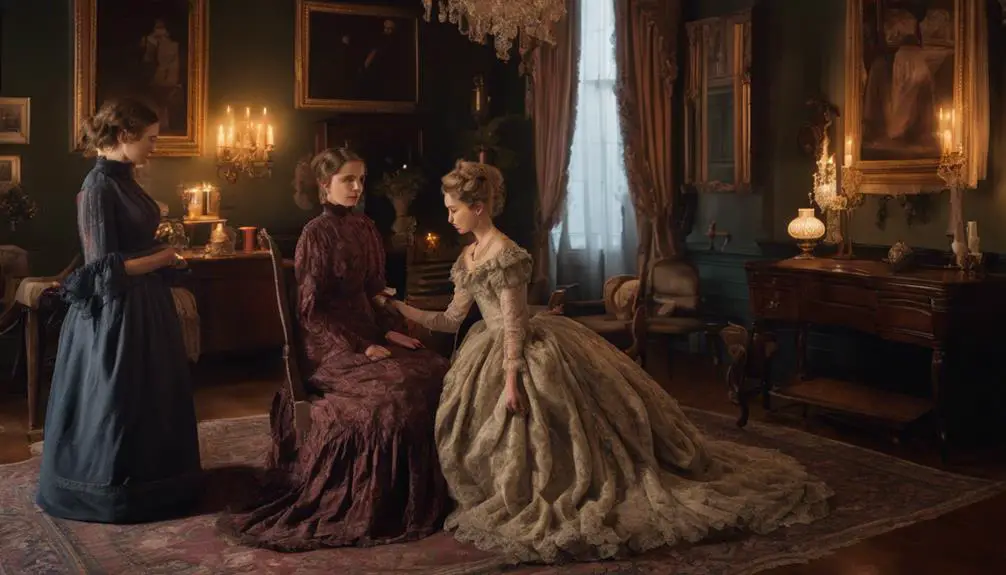
Set against the backdrop of the American Civil War in 1864, "The Beguiled" presents a complex tapestry of historical context and accuracy that invites scrutiny. While costume designer Stacey Battat aimed for authenticity in portraying the lives of Southern women, some choices raised eyebrows regarding historical accuracy. You might notice a few key aspects:
- The use of ethereal pastel colors and light fabrics seemed impractical for a war-torn environment.
- The film lacks the traditional mourning attire that would have been common due to the social upheaval of the time.
- The absence of hoop skirts and proper accessories highlights significant lapses in authenticity.
- Critics pointed out that the polished appearance of costumes didn't reflect the wear and tear typical of daily life during the Civil War.
Moreover, the omission of black characters from the film, who were present in the original novel, raises concerns about the portrayal of slavery and the broader historical context of the era. Overall, while "The Beguiled" attempts to depict a specific moment in time, it invites you to reflect on how historical accuracy shapes our understanding of the past.
Fashion Industry Insights
When you watch films like "The Beguiled," you can see how costume design plays a pivotal role in storytelling. Designers like Stacey Battat showcase their artistic contributions by crafting a cohesive visual narrative that enhances the film's themes and characters. This collaboration between directors and costume designers highlights the significance of visual storytelling, especially at prestigious events like the Cannes Film Festival, where costume aesthetics take center stage. The careful selection of materials and designs often mirrors past fashion trends, as seen in the rich history of iconic brands like Chanel, which reflects vintage Chanel tag evolution.
Historical fashion trends often inspire modern costume design, bridging the gap between past and present. As you observe the characters in "The Beguiled," you might notice how these influences shape audience perceptions, guiding your understanding of their motivations and backgrounds. The interplay between fashion trends and costume design fosters intriguing discussions about accuracy and creative interpretation, ultimately enriching the viewing experience.
Furthermore, the recognition of costume designers is on the rise, with awards underscoring their importance in cinema. As you explore deeper into the fashion industry, you'll find that the impact of costume design extends beyond the screen, influencing contemporary fashion and sparking new trends, all while enchanting audiences with its rich storytelling potential.
Frequently Asked Questions
What Fabrics Were Primarily Used in "The Beguiled" Outfits?
You'd think outfits are just fabric, but in "The Beguiled," silk textures and lace details blend with cotton variations, velvet richness, and linen comfort, showcasing pattern choices, color symbolism, garment silhouettes, and clever layering techniques.
Who Designed the Costumes for "The Beguiled"?
You'll find that the costumes in the film were designed by a talented designer who focused on historical accuracy, character development, and thematic elements, using color symbolism and fabric selection to enhance visual storytelling and era representation.
How Do Costumes Influence Viewer Perception of Characters?
You might think costumes are just decorative, but they shape your perception of characters profoundly. Through visual storytelling, they enhance emotional resonance, express identity, and provide societal commentary, deepening viewer engagement and fostering character empathy.
Are There Any Costume Replicas Available for Fans?
You'll find costume replicas available through various online stores, catering to fans seeking character inspiration. These pieces often blend historical accuracy with fashion trends, perfect for costume parties, events, or as collector items for dedicated enthusiasts.
What Was the Budget for the Costume Design in "The Beguiled"?
Imagine weaving a tapestry; each thread represents a costume budget. For "The Beguiled," designers balanced historical accuracy, character symbolism, and thematic representation, creating a visually stunning narrative through careful fabric choices and a rich color palette.
